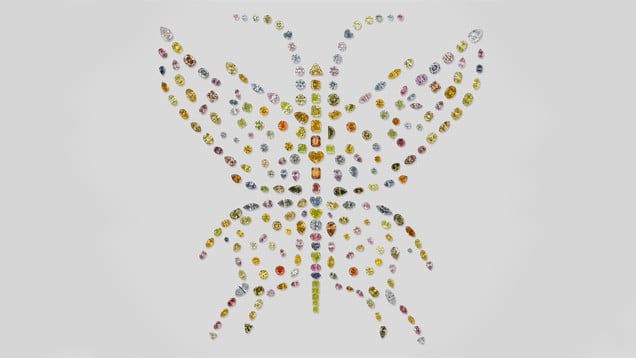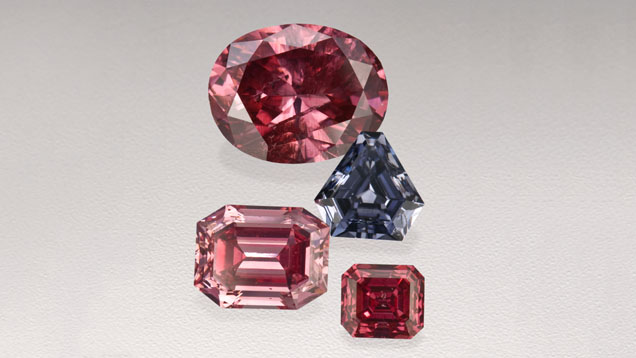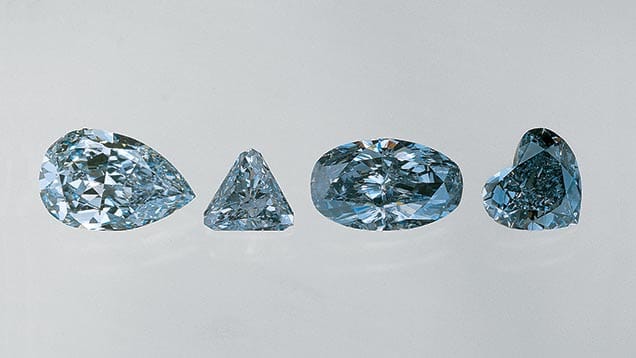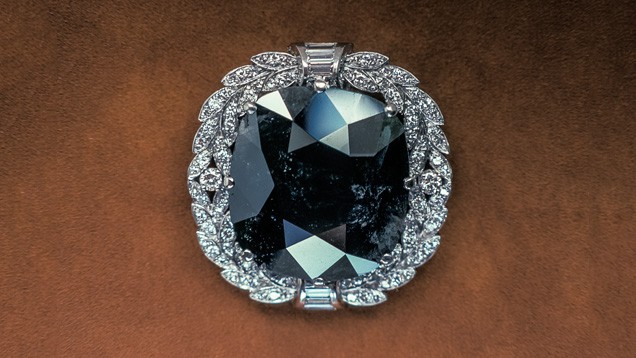Fancy Colored Diamonds
What You Should Know About Color, Clarity, Cut, Carats, and Value
Fancy colored diamonds come in almost any color you can imagine and are rare, precious diamonds. Red, green, purple, and orange are generally the most rare, followed by pink and blue. Yellows and browns are the most common fancy colors, but they’re generally less valuable than the rarer colors. Gem diamonds in the D-to-Z range usually decrease in value as the color becomes more obvious. Just the opposite happens with fancy color diamonds: Their value generally increases with the strength and purity of the color. Large, vivid fancy color diamonds are extremely rare and very valuable. However, many fancy diamond colors are muted rather than pure and strong.
Diamonds in the normal color range are colorless through light yellow and are described using the industry’s D-to-Z color-grading scale. Fancy color diamonds, on the other hand, are yellow and brown diamonds that exhibit color beyond the Z range, or diamonds that exhibit any other color face-up. These rare specimens come in every color of the spectrum, including, most importantly, blue, green, pink, and red.
The most well-known historical and current sources of fancy color diamonds are India, South Africa, and Australia. Other diamond mine locations, including Brazil, Venezuela, Guyana, and Indonesia, also produce fancy color diamonds. So, what are the 4 C’s of fancy colored diamonds? Continue to read about the four C’s of diamonds below!
Fancy Colored Diamonds and The Color Grade
In diamonds, rarity equals value. With diamonds in the normal range, value is based on the absence of color, because the colorless (whitest) diamonds are the rarest. With fancy color diamonds—the ones outside the normal color range—the rarest and most valuable colors are saturated pinks, blues, and greens. In all cases, even very slight color differences can have a big impact on value.
Compared to fancy yellows and browns, diamonds with a noticeable hint of any other hue are considerably rarer. Even in light tones and weak saturation, as long as they show color in the face-up position, they qualify as fancy colors. Red, green, and blue diamonds with medium to dark tones and moderate saturations are extremely rare.
Grading fancy color diamonds is complex and specialized, and it takes highly trained laboratory graders to complete these reports accurately.
Red Diamonds
Diamonds with red or reddish colors are extremely rare and highly valued. Pure pinks are more popular than diamonds that are purplish, orangy, brownish, or grayish. Trade professionals refer to some very attractive stones in this category as “rose-colored,” and some stones with purplish tints as “mauve” diamonds.
Blue Diamonds
Blue diamonds are extremely rare. They generally have a slight hint of gray, so they’re rarely as highly saturated as blue sapphires. Their color is caused by the presence of boron impurities—the more boron, the deeper the blue.
Green Diamonds
Fancy green diamonds are typically light in tone and low in saturation. Their color often appears muted, with a grayish or brownish cast. The hue is generally in the yellowish green category. In most green diamonds, the hue is confined to the surface, and rarely extends through the entire stone. That’s why cutters try to leave as much of the natural rough around the girdle as possible.
Green diamonds get their color when radiation displaces carbon atoms from their normal positions in the crystal structure. This can happen naturally when diamond deposits lie near radioactive rocks, or artificially as a result of treatment by irradiation.
Naturally colored green diamonds are extremely rare. Because of their rarity and the very real possibility of treatment, green diamonds are always regarded with suspicion and examined carefully in gemological laboratories. Even so, advanced gemological testing can’t always determine color origin in green diamonds.
Brown Diamonds
Brown is the most common fancy diamond color and also the earliest to be used in jewelry. Second-century Romans set brown diamonds in rings. In modern times, however, they took some time to become popular.
Brown diamonds were typically considered good only for industrial use until the 1980s, when abundant quantities of them began to appear in the production of the Argyle mines. The Australians fashioned them and set them in jewelry. They gave them names like “cognac” and “champagne.” The marketing worked, and brown diamonds are found in many medium-priced jewelry designs today. Today, the Argyle mine still produces brown diamonds, but it’s more famous as the world’s major source of rare pink diamonds.
Brown diamonds range in tone from very light to very dark. Consumers generally prefer brown diamonds in medium to dark tones with a warm, golden to reddish appearance. They generally show a hint of greenish, yellowish, orangy, or reddish modifying colors.
Yellow Diamonds
Yellow is diamond’s second most common fancy color and are sometimes marketed as “canary.” While this isn’t a proper grading term, it’s commonly used in the trade to describe fancy yellow diamonds. These rare but beautiful diamonds are used in a variety of pieces, including earrings, rings, pendants, and more.
Black Diamonds
Until the late 1990s, there was not much demand for black diamonds. But designers started using them in jewelry, especially contrasted with tiny colorless diamonds in pavé settings, and they began to gain in popularity.
Clarity of Fancy Colored Diamonds
With fancy color diamonds, color is the dominant value factor. Even diamonds with numerous inclusions that result in a low clarity grade are prized by connoisseurs if they display attractive face-up color. Of course, inclusions that threaten the gem’s durability can lower a fancy color diamond’s value significantly. Fancy color diamonds can exhibit color graining, which is also considered an inclusion. To learn more about clarity of diamonds, click here for valuable information from GIA.
Cut
Size and shape are two aspects of cut that can influence diamond color. The larger a diamond is, or the deeper its pavilion, the farther light can travel in it. This can often lead to a richer, more intense color.
The style of the cut can also influence color. Cutters discovered that certain styles—typically mixed cuts like the radiant—can intensify yellow color in diamonds that are toward the lower end of the D-to-Z color-grading scale. When carefully fashioned as radiant cuts, many yellow-tinted stones—at one time called “cape” by the trade—can become fancy yellows when viewed face up. This perceived improvement in color increases the value of the diamond. As an added benefit, the radiant style provides higher yield from the rough than a standard round brilliant.
Carat Weight
As with diamonds in the normal D-to-Z color range, large fancy color diamonds are rarer and more valuable than small ones. Colored diamonds come in a variety of shapes and carat sizes depending on what you are looking for.
Buying Fancy Colored Diamonds
If you are looking for beautiful one of a kind fancy colored diamonds, visit Brittany’s Fine Jewelry in Gainesville, Florida. Our showroom features beautiful diamonds from around the world in a variety of different colors, shapes, and sizes. To learn more, call Brittany’s Fine Jewelry







